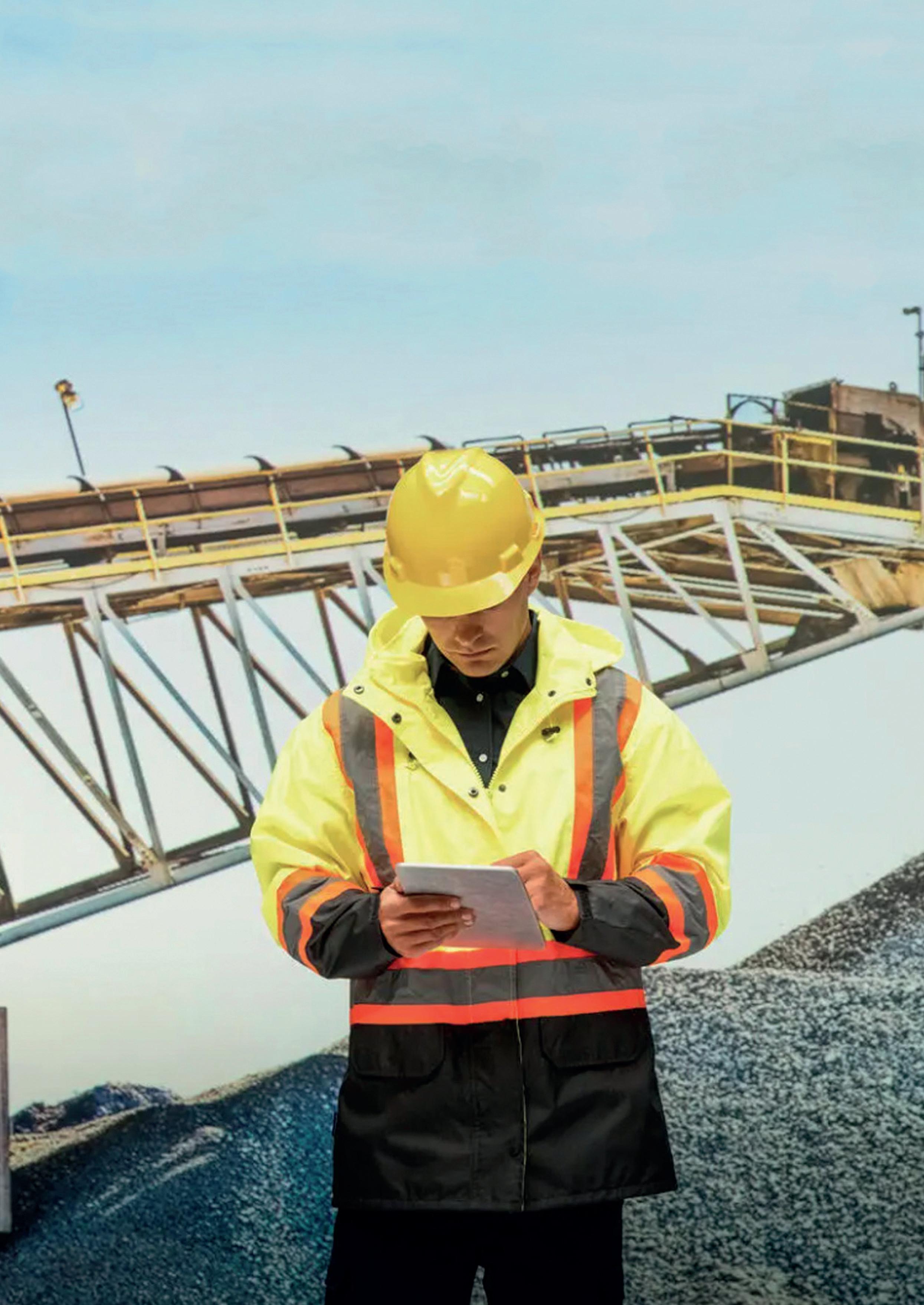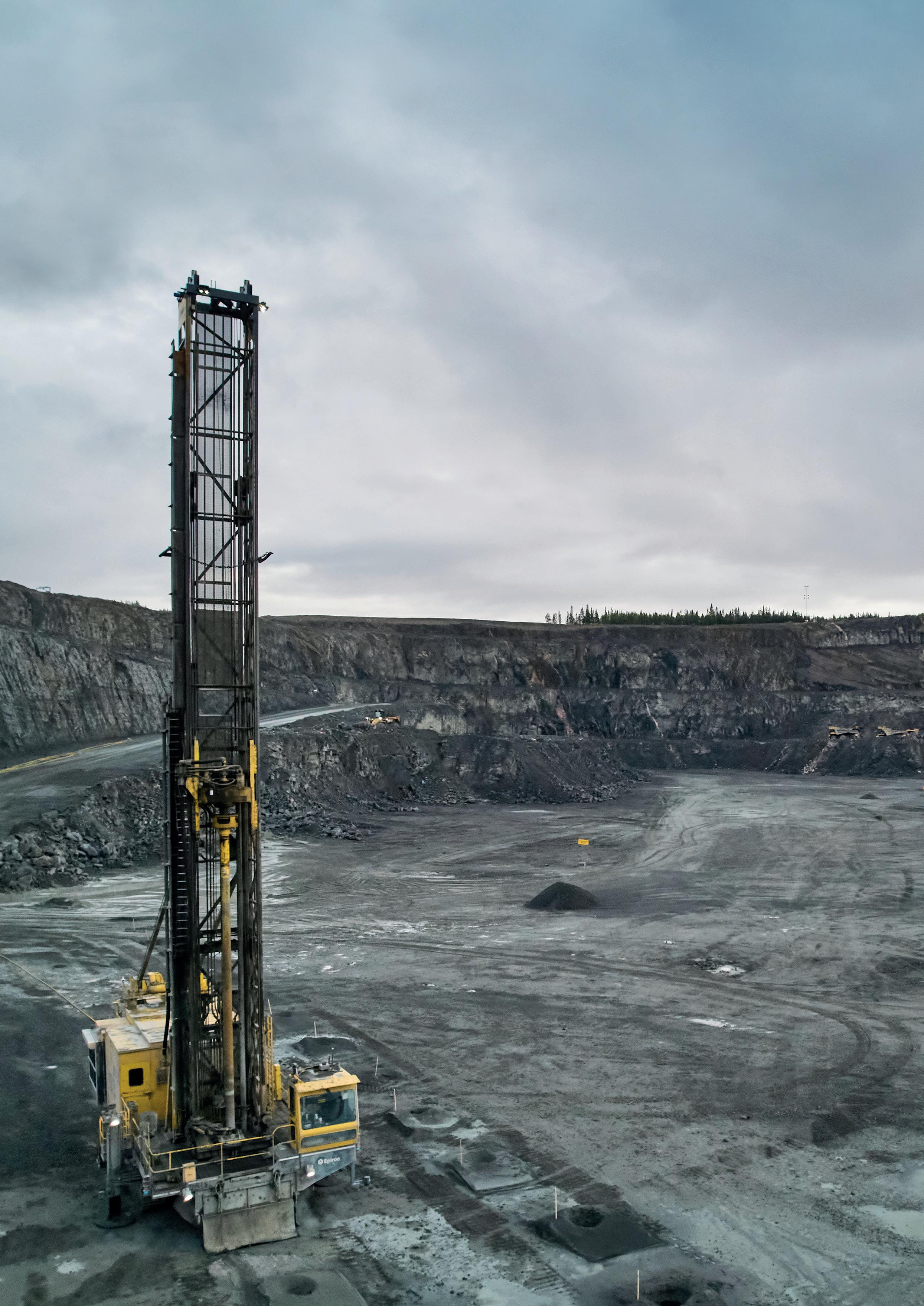
11 minute read
Boosting Mine Power Stability
Power grids serving mines face growing stability and reliability challenges due to the trend for electrification and the transition to renewable energy. Christian Payerl, ABB, Sweden, explains how synchronous condensers can boost network stability.
The global imperative to decarbonise power production is forcing power networks serving mines to evolve rapidly. Both utilities and private mine networks are switching from conventional fossil-fuel thermal plants to renewable energy, usually in the form of intermittent wind and solar power. This has resulted in a dramatic reduction in spinning inertia, otherwise known as kinetic reserve. Inertia is vital to resisting sudden changes, such as when a generator trips offline, so that the grid frequency remains within tightly controlled limits. It is rather like a car’s shock absorbers smoothing out a sudden bump in the road to keep it safely on course.
In addition to the loss of inertia, a lower short circuit level (SCL) can create major problems for mining companies. The SCL defines the amount of current that flows through the system during a disturbance, such as when a generator trips out or an overhead line is struck by lightning. A high SCL is vital during this type of fault as it helps maintain a stable system voltage.
A further important change for the mining industry is the growing adoption of variable speed drives (VSDs) that control the speed of motors, in order to achieve very significant energy savings. However, a side-effect is the reduced capability of the motors to provide inertia and fault current contribution.
In essence, the changing nature of power networks results in weaker incoming grid connections that cause five main issues for mine operations: n Deeper voltage sags. n Higher voltage peaks. n Increased voltage fluctuations. n Increased frequency variations. n Variation of fault current levels over time.
Either individually, or in combination, these issues can cause interruptions to the operation of critical equipment that could result in lost production.
Comparing weak and strong electrical grids
Inertia and SCL are the two different sides of ‘grid strength’, as shown in these four examples of different types of grid:
High inertia and high SCL
n Typical for a traditional power grid based on a large, centralised thermal power plant. n Grid frequency does not change when the load changes. n Voltage variations are small. n Straightforward selectivity for protection against short circuit currents.
Low inertia and high SCL
n Special cases when an induction motor is feeding devices such as fans and other frequency-dependant loads. n Large variations in frequency occur when the load changes. n Voltage variations are small – at least initially. n Short circuit current contribution from rotating machines simplifies protection selectivity with fuses.
High inertia and low SCL
n Typical when a long radial transmission line is feeding a remote operation. n Grid frequency does not change when the load changes. n Large voltage variations are expected, especially for direct online (DOL) starting of motors. n Difficult to provide selective protection with fuses.
Low inertia and low SCL
n Found in microgrids with mostly power electronic connected devices. n Large variations in frequency occur when the load changes. n Voltage variations are possible, but this depends on the response of the power electronics. n Difficult to provide selective protection with fuses.
These last two cases are found typically in mines.
To address the challenges of weak grids, the mining industry is turning its attention to synchronous condensers (SCs) (Figure 1). These synchronous rotating machines were once widely deployed in the global power industry, but have rarely been used in recent decades. This is because the former function of SCs, which was to provide reactive power compensation, has been replaced by modern semiconductor-based equipment. However, there is renewed interest in the capability of SCs to deliver physical inertia for grids. This provides instantaneous support to maintain stability irrespective of the upstream network voltage or frequency.

Figure 1. Typical synchronous condenser installation.
Reducing risk
There are three main ways that SCs can help to reduce risk for mine networks:
Inertia support for frequency stability
Balancing supply and demand is critical to maintaining a stable grid frequency. Historically, this was self-regulated by the large spinning inertia provided by traditional rotating generators. However, the variety of non-synchronous resources on the grid – such as wind, solar, tidal, and battery energy storage (BESS) – results in an increased rate of change of frequency that can cause systems to trip offline. The rotating mass in an SC provides the instantaneous inertia to keep the grid frequency within acceptable limits. It also helps by damping frequency excursions and providing more time for the operator to take suitable action to respond to frequency changes.
Fault level contribution
When network faults occur, non-synchronous generators are unable to provide instantaneous support to avoid unnecessary tripping of loads. Their fault current capability is controlled to a level that is close to the nominal current. In contrast, the fault current response of the SC is uncontrolled and defined by its electrical parameters. This means that the fault current can be high – possibly five times the nominal current, or even higher.
There is a simple reason why fault current is so important. It is because the majority of the installed protection systems monitor the difference between a normal operating current and phenomena such as inrush currents and fault currents. This difference must be big enough to be detected easily, otherwise it is hard to protect critical assets such as transformers or switchgear.
Another important point is that measures of power quality (such as voltage harmonics, unbalance, and flicker) relate to a defined fault level in the system. If this fault level is reduced by introducing significant levels of renewables, then power quality issues will increase. This may result in the overriding of power quality limits or a direct negative impact on the connected loads, such as overloading of rotating machines and transformers, or disturbing electronic devices.
Voltage regulation
SCs also deliver megavolt amperes reactive (MVars) for voltage regulation. An SC cannot provide active power; it only provides reactive power. In an undervoltage condition, such as when there is a voltage dip, reactive power is produced to support the grid voltage. Equally, in an overvoltage condition, where the voltage is becoming too high, reactive power can be absorbed.
What is a synchronous condenser?
An SC is a synchronous machine, but it is not a motor since it does not drive anything. Neither is it a generator, as there is no prime mover. However, it is very similar to a generator in its design and behaviour and produces reactive power.
The machine is usually water cooled, as this is one of the most effective ways to dissipate the heat losses and it is designed to be used both indoors and outdoors in different ambient conditions. However, other cooling options, such as air-to-air cooling, are also possible. Its brushless design is particularly important for reliability in the dirty and dusty conditions found in the mining industry.
For starters, a small pony motor of approximately 200 – 300 kW is coupled to the SC. It is controlled by a drive that ramps up over a few minutes to bring the speed of the SC into synchronous operation, usually at 1500 rpm in 50 Hz systems or 1800 rpm in 60 Hz systems. At the right moment, the synchronisation procedure will switch the machine online, ready to support the network.
Typically, SCs are supplied in ratings up to 80 MVAr and 3 – 15 kV system voltage. The network voltage is usually much higher, so a step-up transformer is used. Higher outputs are reached by using several units in a standardised modular configuration. This offers better redundancy and availability compared to one large unit.
An important new development for SCs is a high-inertia configuration. This couples a mid-sized SC with a flywheel and increases the available inertia by several times, while the losses are much lower compared to installing the whole inertia as an SC.
SCs are tailored for specific locations, according to network studies. This enables the creation of pre-designed SC packages that are easy to transport, install, commission, and integrate. They are based on small or medium sized modules that can be strategically sited for optimal results. This provides a decentralised solution to increase grid strength and stability.
How can SCs address specific power quality problems in a mine?
As shown in Figure 2, power quality problems can impact a number of different areas in a mine. This starts with the incoming grid connection that can be fed by a weak network, resulting in problems such as voltage sags, peaks and fluctuations, as well as variation of the fault level. These can be addressed by installation of an SC.
Furthermore, the often-remote location of mines can mean that active power transfer is a problem due to the inductance of the long power line. An SC can help increase the stability margin above the critical voltage level, so that the mine will be more immune to grid faults, with less tripping of essential equipment. The increased voltage also means that more power is available for mining equipment. By increasing the maximum active power that the mine can consume, the SC also provides headroom for future expansion.
The start-up of large inductive loads (such as mine hoists, gearless mill drives [GMDs] and motors) triggers a large reactive inrush current. This produces a voltage drop that can cause tripping of protection equipment. It can also result in system instability, with potential for voltage fluctuations, increased harmonics, increased losses, and limitation of simultaneous start-up loads. An SC will reduce the impact of these voltage variations and dips.
During start-up of large grinding machines, typically with loads of 20 – 30 MW, the voltage can drop by 15% for a period of up to 30 secs. In the case of load rejection, which occurs when there is a sudden load loss in the system, the voltage can rise quickly by more than 10%. This can be even higher in weak networks.

Figure 2. Power quality issues can arise across a wide variety of mine applications.
Both scenarios can lead to system instability and cause unnecessary tripping of equipment. This can be avoided with an SC that reacts swiftly to counteract all fluctuations in voltage and limit any voltage drop or rise.
Motors with heavy loads, as well as submerged arc furnaces (SAF) and electric arc furnaces (EAF), consume high amounts of MVArs. This impacts the plant power factor and voltage stability. Furthermore, as well as disturbing the plant’s own power quality, electric furnaces can also disturb the connected grid.
An SC can increase the fault current capacity at the connection point, with a consequent reduction in voltage variations, flicker, harmonics, and imbalance. Moreover, the dynamic MVArs provided by the SC will also limit the voltage variations.
Practical SC applications in mines
Case study: Peru
In 2013, ABB completed the commissioning of two SCs and harmonic filters for Xstrata Copper’s Antapaccay project in southern Peru. The project is located in a remote area and connected by a long power transmission line. The SCs ensure accurate and dynamic power factor compensation for safe and reliable operation at the mine. By integrating SCs and harmonic filters the harmonics are mitigated and short circuit levels improved, optimising Antapaccay’s productivity and energy efficiency.

Figure 3. Two ABB SCs have been installed at the Copper Mountain mine in Canada. Case study: Canada
Copper Mountain mine near Princeton, British Columbia, is Copper Mountain Mining’s flagship site (Figure 3). It is a conventional opencast, truck and shovel operation which produces approximately 45 000 tpy of copper equivalent. As the operation moves to electrification, ABB has installed two SCs, each rated at 13.8 kV with a continuous output of +25/-12.5 MVAr and a short-term (30 mins.) output of +45/25 MVAr.
SCs in future mines
Mines are becoming increasingly electrified. This includes the adoption of battery electric vehicles (BEVs) for both underground and surface operations, which reduce emissions and enhance energy efficiency. Fast-charging systems for these BEVs place new demands on mine networks, with high inrush currents that impact voltage stability, as well as increasing power demand and potentially introducing harmonics (Figure 4).
Similar challenges apply to the power electronics and drives deployed for pumps, conveyors, and ventilation on demand systems. This is a critical area where SCs can help maintain grid stability.
Delivering a stable future for mine power networks
The drive for decarbonisation is delivering major benefits for all types of power networks, as the world strives for a sustainable future. However, it is creating new challenges due to the loss of inertia as thermal power plants are decommissioned in favour of renewable energy schemes. This is especially true of remote mining operations that, in many cases, are already served by weak power networks. SCs are set to play an increasingly important role in these networks by restoring rotating inertia to provide stability, strengthening the network with added short circuit capacity and providing dynamic MVArs to support voltage control.

Figure 4. Future highly-electrified mines will rely on SCs for a stable power supply.










